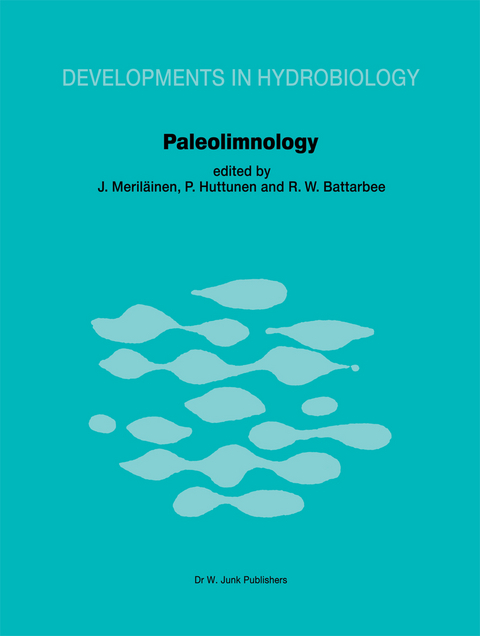
Paleolimnology
Springer (Verlag)
978-94-009-7292-6 (ISBN)
1. Opening lecture: Aspects of the developmental history and paleolimnology of lakes in Finland.- One: Methods and their Applications.- 2. Säynäjälampi and the difficulties inherent in the dating of sediments in a hard-water lake.- 3. The use of fallout 137Cs and 239,240Pu for dating of lake sediments.- 4. Caesium-137 profiles in the sediments of a partial-meromictic lake on Great Sandy Island (Fraser Island), Queensland, Australia.- 5. The assessment of 210Pb data from sites with varying sediment accumulation rates.- 6. Mineral magnetic studies on lake sediments: A brief review.- 7. Global holocene magnetostratigraphy.- 8. The use of magnetic measurements in interpreting the fire histories of lake drainage basins.- 9. Changing patterns of sediment accumulation in a small lake in Scania, southern Sweden.- 10. The use of X-ray radiographic methods in studying sedimentary properties and rates of sediment accumulation.- 11. An automated technique for the accurate positioning of sediment core sites and the bathymetric mapping of lake basins.- 12. Recent climatic changes recorded by the salinity of pore waters in the Dead Sea sediments.- 13. Trace element associations as indicators of sediment accumulation in lakes.- 14. Transfer functions for estimating paleoecological conditions (pH) from East African diatoms.- 15. Interpretation of lake quality from contemporary diatom assemblages.- 16. Bacterial decomposition of organic matter in lacustrine sediments.- 17. Relationship between sedimentary pigments and primary production: evidence from core analyses of twelve Italian lakes.- Two: Lake Changes Related To the Influence of Man.- 18. The mythical concept of eutrophication.- 19. Paleolimnological reconstruction of the effects of atmospheric deposition of acids and heavymetals on the chemistry and biology of lakes in New England and Norway.- 20. Cultural disturbances and trophic history of a small meromictic lake from central Canada.- 21. Diatom and chrysophyte relict assemblages in the sediments of Blelham Tarn in the English Lake District.- 22. Changes in the benthic fauna of the profundal zone of Traunsee (Austria) due to salt mining activities.- 23. Cladoceran remains as evidence of change in trophic state in three Swiss lakes.- 24. Changes in diatom flora deposited annually during the freshening of the impounded, sea-bay of Gennarbyviken in southern Finland.- 25. Eutrophication processes in Spanish reservoirs as revealed by biological records in profundal sediments.- 26. Seasonal eutrophication by wildfowl in basins isolating from the sea: A working hypothesis.- 27. Eutrophication and the disappearance of lakes in the Brodnica Lake District, Northern Poland as a result of human interference.- 28. An attempt to trace eutrophication in a shallow lake (Balaton, Hungary) using chironomids.- 29. Zn, P and ATP in the sediments of two lakes in South Finland.- 30. Clostridium perfringens (Holland) as an indicator of human effluent in the sediment of Lake Tuomiojärvi, central Finland.- 31. Paleolimnological studies of annually-laminated sediments in Loe Pool, Cornwall, U.K..- Three: Regional Paleolimnology.- 32. Recent geologic development of Lake Michigan (U.S.A.).- 33. Paleolimnology of the Peten Lake District, Guatemala I. Erosion and deposition of inorganic sediment as inferred from granulometry.- 34. Paleolimnology of the Peten Lake District, Guatemala II. Mayan population density and sediment and nutrient loading of Lake Quexil.- 35. Paleolimnology of the Peten Lake District, Guatemala III. Late Pleistocene and Gamblianenvironments of the Maya area.- 36. The Holocene development of some low and high arctic Greenland lakes.- 37. Palynological investigations of the sediments of ten lakes in eastern Holstein, North Germany.- 38. Development of Grossensee (Holstein, Germany): variations in trophic status from the analysis of subfossil microfauna.- 39. Stratigraphy of Cladocera and Chironomidae in a core from a shallow North German lake.- 40. Diatom succession in the post-glacial sediments of the Komo?any Lake, North-West Bohemia, Czechoslovakia.- 41. The environmental evolution and infilling process of a former lake near Vracov (Czechoslovakia).- 42. Variability of Actinocyclus kuetzingii (A.S.) Sim. in the Littorina sediments of the Polish Baltic Coast.- 43. Paleolimnological investigations in humid and arid zones of the Soviet Union.- 44. Recent history of Lake Ladoga.- 45. Diatoms in the plankton and sediments of two lakes of different trophic type.- 46. Palynological investigations of the sediments of the north-western lakes of the Russian Plain and the Baltic Sea.- 47. The Middle-Valdaj lakes in the western part of the Bolshezemelskaja tundra.- 48. Sediment formation in Lake Baikal.- 49. Recent stratigraphy and accumulation of sediment in the deep, oligotrophic Lake Pääjärvi in South Finland.- 50. Biostratigraphy of Lake Spitaalijärvi: an ultraoligotrophic small lake in Lauhanvuori, western Finland.- 51. Sysmäjärvi — a lake polluted by mining waste-water.- 52. Sedimentary chemistry of a small polluted lake, Gallträsk, S. Finland.
| Reihe/Serie | Developments in Hydrobiology ; 15 |
|---|---|
| Zusatzinfo | X, 318 p. |
| Verlagsort | Dordrecht |
| Sprache | englisch |
| Maße | 210 x 279 mm |
| Themenwelt | Sachbuch/Ratgeber ► Natur / Technik ► Garten |
| Naturwissenschaften ► Biologie ► Limnologie / Meeresbiologie | |
| Naturwissenschaften ► Biologie ► Ökologie / Naturschutz | |
| ISBN-10 | 94-009-7292-X / 940097292X |
| ISBN-13 | 978-94-009-7292-6 / 9789400972926 |
| Zustand | Neuware |
| Haben Sie eine Frage zum Produkt? |
aus dem Bereich


